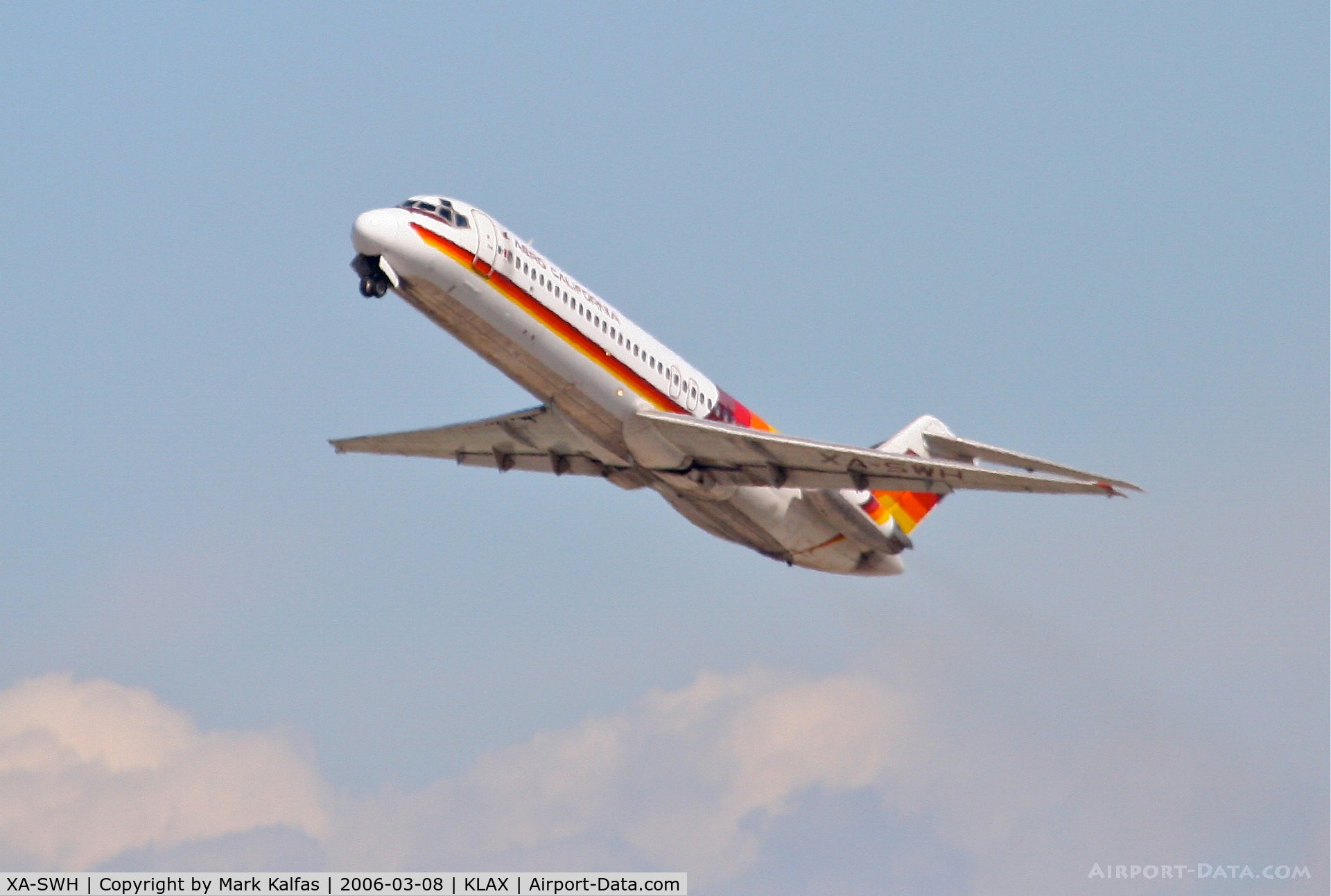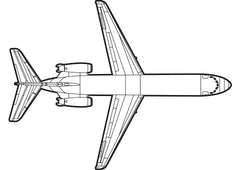
- by Dianna Lopez
DC-9 Aero California: To Baja and Beyond
- by Dianna Lopez
A question? Visit our contact page
This site uses cookies for better user experience and analytics.


By 1965, Douglas Aircraft had produced dozens of incredible wartime aircraft, as well as a succession of popular passenger jets, including the DC-9 which first flew that year. The DC-9 was a single aisle airliner, designed for short to medium routes, and smaller airports which lacked the airport ground services and infrastructure of the larger airports. It was equipped with features like airstairs to aid passenger loading and unloading without the need for external airport stairs. It also had its own A.P.U. (Auxiliary Power Unit) to supply electricity to the airplane while on the ground as well as the power to start the main engines. At the time, it was often called the workhorse of passenger jets, with 976 of these reliable aircraft produced until 1982.

Douglas Aircraft would soon after merge with McDonnell Aircraft Corporation to form McDonnell Douglas Corporation, producing many more military and commercial planes. McDonnell Douglas later merged with its rival Boeing. The mighty aircraft produced by each of these manufacturers is truly incredible.


Aero California was a privately owned airline, based in La Paz, Baja California Sur, Mexico. It was founded in 1960 as a small regional airline called Servicios Aéreos, using Beechcraft 18s. By the 1970s the airline had rebranded as Aero California, adopting its colorful livery and adding DC-3s and new routes within Mexico. Eventually, Aero Cal introduced its first jet flights, using DC-9 aircraft to transport passengers between cities all over Mexico.

In 1989, it began offering its first international scheduled service between Los Angeles and La Paz, Los Cabos, and Loreto. It operated a DC-9-30 fleet, configured for tourist class with a capacity of 115 passengers. The airline was grounded in 2006 for safety concerns, amidst charges that mechanics were using parts from decommissioned planes to keep their fleet in the air. After flights resumed, the airline was grounded for good by the Mexican government in 2008, due to a debt owed to the Mexican Air Traffic Control.

After spending the first 25 years flying for Alitalia as “Isola di Pianosa,” our DC-9 spent its final 12 years with the Aero California fleet. XA-SWH was one of 22 DC-9s used to transport passengers between major destinations within Mexico and to Los Angeles. It was withdrawn from use in April 2006, then stored at Mojave Air and Space Port near Los Angeles, California from September 2006 to the present.

XA-SWH caught the eye of MotoArt owner Dave Hall while he was on site at the MotoArt storage facility at Mojave. “The colors on this plane are just fantastic. Even seeing it sitting out in the desert, tired and dusty, we could see its potential,” says Hall. He acquired the DC-9 in 2020 and was excited to introduce it as the first PlaneTags of the new year.

Each PlaneTag begins with an aircraft slated for destruction. By the time MotoArt acquires it, it has already been stripped of many of its avionics and assets that can be resold or recycled. We source aircraft from all over the world but we do get many at Mojave Air & Space Port because it is right in our backyard, so to speak.

Our team cuts panels from the fuselage and tail right on the spot. We are often asked why we cut them in these smaller pieces and not large pieces. Simply put, these are easier to work with and we can focus on safely cutting the skin and not the frame under it.

Although we cut the pieces where the plane sits, they are transported back to MotoArt. Our craftsmen hand stamp each piece. They are also cleaned and polished by hand before being engraved.

Laser etching is also done in-house at MotoArt, with great care to ensure that the correct information is included. We make the occasional mistake, which are hopefully caught during production, but have sometimes gone out into the world. These mistakes are destroyed so that no one receives a shoddy or poor quality product.

We are often asked if we paint or lacquer or alter the paint in any way. We don't. We clean the PlaneTags and polish them but the paint - including chips, dings and anomalies - is the plane's own. This is why some PlaneTags are very shiny or aged or have patina.

Our DC-9 PlaneTags are numbered to 5,000, making this a limited edition. They are available in yellow, red, orange, and wine, and in a variety of colorful combinations.
From the start, our commitment has been to create a heirloom-worthy piece of history that you are proud to display, or to carry, or to give as a gift. We are looking forward to sharing more amazing aircraft with you in 2021.
Did you miss these PlaneTags?
From Warbird to Water Bomber: The Epic Life of the Hawaii Mars
In the world of aviation, few aircraft have lived a life as large, or as long, as the Hawaii Mars. Towering over most of its contemporaries with a wingspan of 200 feet, this mighty flying boat was born in the final days of World War II, then quietly transformed into one of the most iconic aerial firefighting aircraft the world has ever seen. From military transport to firefighting titan, the Hawaii Mars represents one of aviation’s most extraordinary second acts.
In 2025, MotoArt obtained an original wing of this aircraft and created special PlaneTags, made exclusively for the Martin family members and Mars workers. On December 11, 2025, Hawaii Mars PlaneTags will be available to the general public for the first time.
F-14 Tomcat Coasters: A Legendary Fighter Reimagined for Your Home
Few aircraft define an era quite like the Grumman F-14 Tomcat. Sleek, powerful, and unmistakably iconic, the Tomcat was the Navy’s premier fleet defense fighter for more than three decades. From Cold War missions to pop culture stardom, the F-14 remains one of the most recognizable and beloved aircraft ever built. Today, MotoArt is proud to introduce the F-14 Tomcat Coaster Set, created from authentic F-14 aircraft material.
PR-AJB: The Story of an Azul Airbus A320 With a Global Journey
Every airplane has a story, and some travel farther than others before their flying days are over. PR-AJB was one of those well-traveled aircraft. This Airbus A320 started its life flying British families on long-awaited holidays, then later crossed the Atlantic to join the growing fleet of Azul Linhas Aéreas Brasileiras. Over nearly nineteen years it picked up new registrations, new paint, new routes and a new home, carrying thousands of passengers along the way.
Its journey reflects how widely the A320 family has spread around the world and how easily these aircraft adapt to whatever their next chapter requires. PR-AJB also arrived at Azul during an important period of expansion as the airline worked to connect more cities across Brazil. In this blog we will explore where the aircraft came from, what it did during its short time with Azul, and how it eventually came to rest in Florida. We will also share how MotoArt recovered material from the retired airframe and created PlaneTags so its story can continue in a new way.


Share:
Best Aviation Gifts Under $50 | New for 2020
P-51K Mustang: One Plane's Journey